Tribal Art Forms of India:
India has always been famous for its artwork and architecture. India has a long and rich artistic history. Nearly every single state has a particular art form with a specialty. And the most vivid art comes from Indian tribal cultures. Due to the highly specialized rites and qualities of these tribal artworks, they are rich in symbolism. Here are some famous tribal arts:
Bhil Art:
The second-largest tribe in India is the Bhil. They also provide Bhil art. state of Rajasthan, Madhya Pradesh, Gujarat, and Maharashtra origin. This work reveals the Bhils’ own lives. This tribe employed dots to paint images of life in vivid hues. They make an effort to relate their paintings and art to their Gods, Goddesses, and the natural world. This contains carvings made from natural and herbal colors of the Sun, Gods, Moon, and nature, on paper or wall. The narrative behind the picture is simple to comprehend.
Gond Art:
This art, which is carved on mud brick, is from the Madhya Pradesh region and neighboring states. These paintings are full of interesting features, lines, colors, and humor. These artworks are also drawn on materials like paper, canvas, and clothing. Lines, dashes, and dots are prominent elements in these artworks. This painting is created for significant holidays like Holi and Diwali, among others.
Pattachitra painting:
Pattachitra paintings are ancient works of art that have their roots in Odisha and West Bengal. It is a fabric painting that features floral border designs and clear, fine lines in vibrant colors that depict Goddesses and Gods. These paintings were once used to tell stories. The manner that clothing is shown sets this work apart from other forms of expression. These artworks are done on canvas, or (Patta.) It is among the earliest forms of tribal art found in India. A genuine Pattachitra painting is supposed to be produced entirely of natural pigments and can take weeks to finish.
Kalamezhuthu Art:
The ritual artwork of Kerala, the land of God, is known as Kalamezhuthu. Drawings are called (Ezhuthu) and (Kalam) respectively. This painting is seen during festivals and other special events. It draws in a particular style. Before creating the sacred god, numerous remedies are taken into account, including the deity, natural pigment, proportions, color preference, etc. After that, he is praised in songs and idolized. The artwork erases by performing ritual dance movements on it.
Khovar Art:
Var means spouse, while Kho signifies cave. The females of the home create this matriarchal artwork to adorn married couples’ wedding suites. Jharkhand is the birthplace of khovar art. Firstly, a coating of black mud is applied to the backdrop, then a layer of white mud is applied. After that, the coating is peeled off with a tool to create the desired shape. Typically, tribal people who live in the jungle carve creatures like tigers, snakes, peacocks, etc., while those who live on plains generally carve creatures like cows, goats, pigeons, etc.
Kavad Art:
About five hundred years old, the Kavad artwork (from Rajasthan) is still being practiced today by Jangid Brahmins from Chittorgarh. It is a three-dimensional container with numerous unfoldable panels. It is a movable temple decorated with paintings of many Goddesses and Gods. These panels, which are formed of light wood, feature tales from numerous epics, including the Puranas, and Bhagavad Gita.
Rogan Paintings:
Rogan painting is a form of textile printing popular in Gujarat. Use paint created from boiled oil and natural dyes to produce designs on fabric. Originally gaining its current reputation as a rare and expensive form of art, Rogan, which has its origins among some of the Khatris, was primarily a seasonal artwork. The art form continues to exist despite the current dearth of practitioners as one of India’s many indigenous tribal specialties.
Warli Art:
Warli paintings are a form of tribal artwork that originated in the Indian state of Maharashtra and have a long history that dates back to the (10th century A.D). Warli art essentially gained popularity as wall paintings, using nature mainly. The Warli art stands out in its characteristic white designs against the typical red mud basis of the walls.
Phad Art:
Phad is a religious kind of painting that is native to the royal state of Rajasthan and features images of local deities. This artwork, which is typically drawn on a large length of fabric or canvas called a phad and gives it its name, provides a colorful image that serves as a portable temple for the deities it depicts. This historical artwork is significant both culturally and religiously and is extremely detailed in its vivid images and presentation.
Paitkar Art:
Paitkar Paintings, a type of tribal art from India, are known as the famous paintings of Jharkhand and have long served as the inspiration for religious and social practices. Paitkar paintings, which are almost a variety of pattachitra, have come to be largely linked with the Hindu epics, even though themes like death also find considerable representation in their world.
Kalamkari Art:
It is one of the extremely popular Indian art forms that primarily manifests itself as fabric painting. Even though it originated as a storytelling artwork, this pervasive style of art finds its greatest expression in sarees due to the skill demonstrated through kalams. Kalamkar is a true fusion of the arts with representations that include scenes from Hindu iconography and mythology that shows Persian influences in patterns and design.
Pithora Paintings:
It’s a form of tribal artwork from Gujarat. The creators of this form of art, which also functions admirably as a kind of religion, are the Bhilala and Rathwa tribes. Even the painting itself, which is done on the center wall and the two walls on either side, is performed in a ritualistic manner. Yet, even how current conventions define this style of expression as a particular genre of painting, for the Rathwas.
Sohrai Art:
The Sohrai artwork is another example of Indian tribal art that has popularity. Natural ochre hues enhance the appeal of this classical and ritualistic art, which highlights a series of dots and lines forming up natural features with also religious allusions. These art forms are already remarkable in their elaborate designs and impressive colored motifs. Another art genre that maintains a strong connection to nature is abstract painting, which uses natural materials like clay and charcoal to create its aesthetic sense.
Manjusha Paintings:
Manjusha art started in Angpradesh, now known as modern-day Bihar, and is one of several Indian art styles with historical significance. This tribal artwork is considered to be the unique form of art in India that expresses itself as a serial depiction of a story. This artist’s work, which has roots in the 7th century and is distinctive to the Bishahari Puja, is currently being revitalized. This extremely religiously important art form is characterized by swirling snakes.
Dhokra Art:
It is a traditional art from Odisha, Jharkhand, and Chattisgarh West Bengal. Those who adore handcrafted items are quickly seduced by the tales and their depiction in these metal artifacts created of bronze and copper-based alloys using lost wax casting techniques. The casting of non-ferrous metals utilizing the lost-wax casting method is called Dhokra. India has been using this type of metal casting for more than 4k years. Because of its simple primitive design, captivating folk patterns, and strong shape, the work of dhokra artisans has been highly sought after in both domestic and international markets.
Godna Art:
Godna is a tribal ornament that symbolizes the individuality of these creatures and their long history in antiquity. The act of getting a tattoo is motivated by religious convictions, a desire for compassion, and humanistic aspirations. As an homage to numerous tribes, tattooing is still popular in Jharkhand, India. The act of releasing veggie juice, mixed with soot and oil, through the needle’s point or by adopting it has been defined as tattooing. The most famous tattoo designs were geometric shapes, the moon, hand-foot raid, and the sun. Most women are the only ones who get tattoos, but guys aren’t far behind.
Pichwai Art:
Town of Nathdwara, where the painting style known as Pichwa first appeared about 450 years ago. Pichwai paintings, created on fabric, are intricate and visually appealing representations of stories from Lord Krishna’s life. A pichwai may take months to create and is extremely difficult to do since even the smallest elements must be painted precisely. Shrinathji, the deity who appears as a seven-year-old kid in Pichwais, is a popular way that Lord Krishna is portrayed. Radha and cows are additional typical pichwai painting themes.
Rangoli Art:
Rangoli is a decorative art form that is painted on floors or the home entryway. It is said to welcome guests, and success to the home. On holidays like Diwali, some Indian mothers perform this ritual every morning. Women teach their children the art of Rangoli, which is a folk artwork that is passed down from one generation to the next. Rangoli patterns can be quite simple with just geometric or flowery shapes, or they may be extremely complex. Peacocks and fish are some of the often-utilized motifs in rangoli.
Tanjore Paintings:
Term (Tanjore) refers to a style of artwork whose inspiration first emerged during the Vijayanagara era. Slim figures, distinguishable features, and the characters’ prominent second eye are characteristics of Vijayanagar paintings. The Marathas, who were foreigners in the South, preserved the native Thanjavur art style while introducing secular themes and European concepts. Themes from Mahabharata and Ramayana, are two ancient Hindu epics. Another fundamental aspect of Tanjore art is its ongoing link with the royals, which results from the time-consuming process of creating these works of art.
Toda Tribal Art:
The Toda art is also famous as (Pukhoor). The embroidery is done with black and red threads on a cotton fabric white color surface. The Toda people are proud of their history and the embroidered fabric is useful. The embroidered shawls are used by both women and men to beautify themselves.
Featured Articles
Enter the beautiful world of Art which is full of stories, history and orgin of different art forms. There is some thing every day.
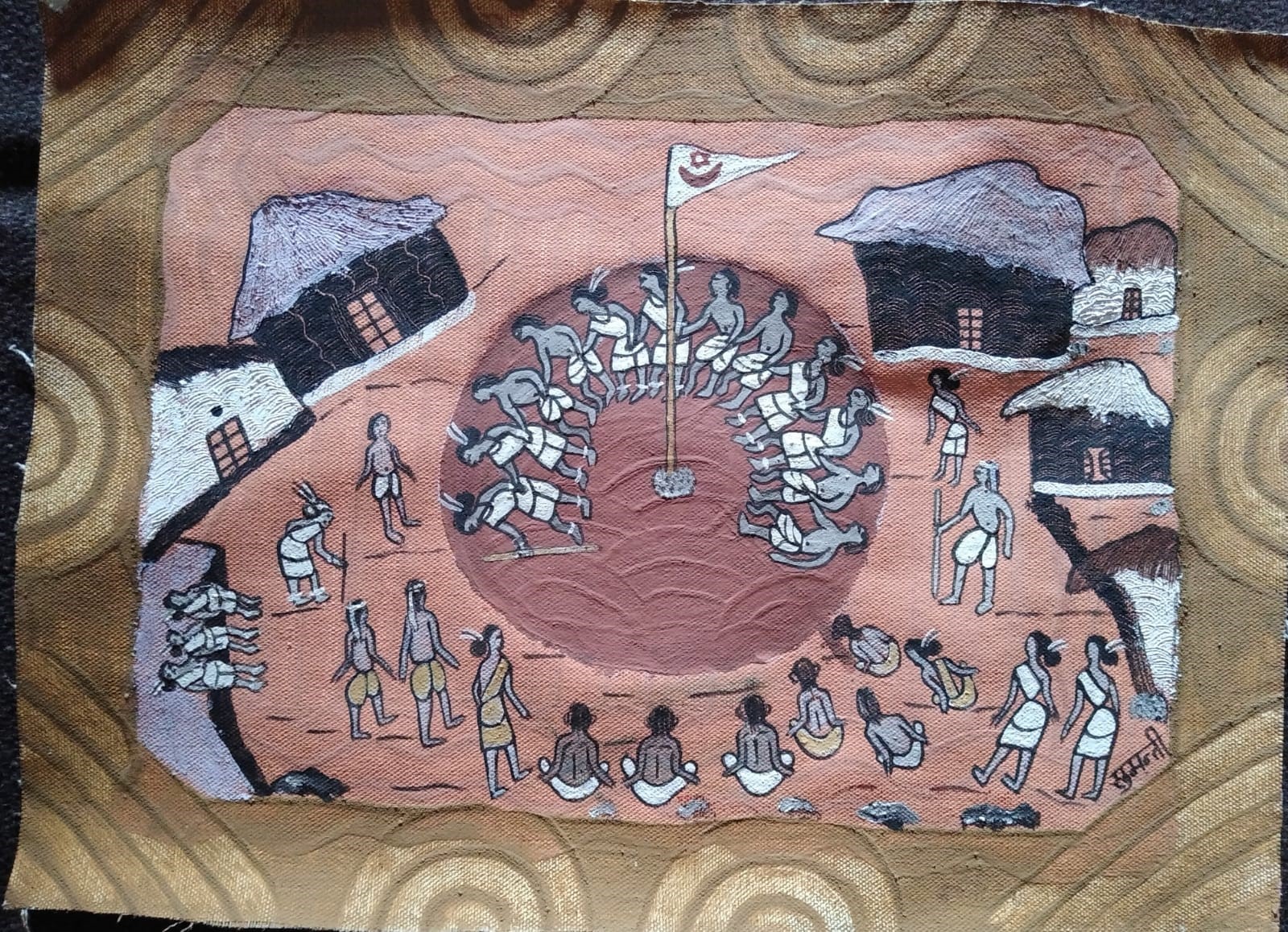
ORAON ART
The ancient artistic work of Oraon represents folk ideas, customs, and conceptions, as well as defining the roots of human characteristics. The elements that they use to create their colors are charcoal, green leaves, and red clay.
These paintings are notable for their adherence to certain motifs, colors, and figures for various events and festivals.
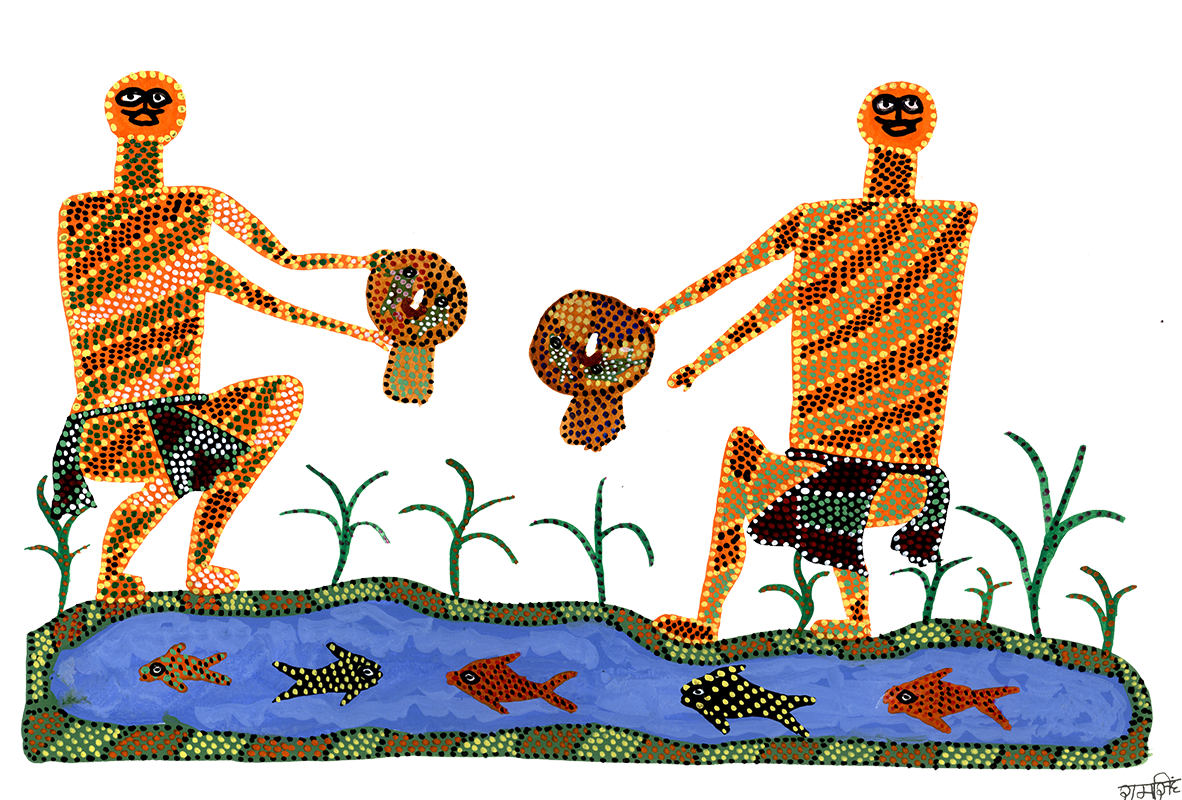
BHIL ART
With its colorful and simple designs, tribal artwork has gained appeal in recent times. Bhil art is defined by the dots that cover the full background. The dots are masterfully repeated in wonderful patterns and colors throughout the painting. Bhil art is identified by its dots, which have several elements of symbolism
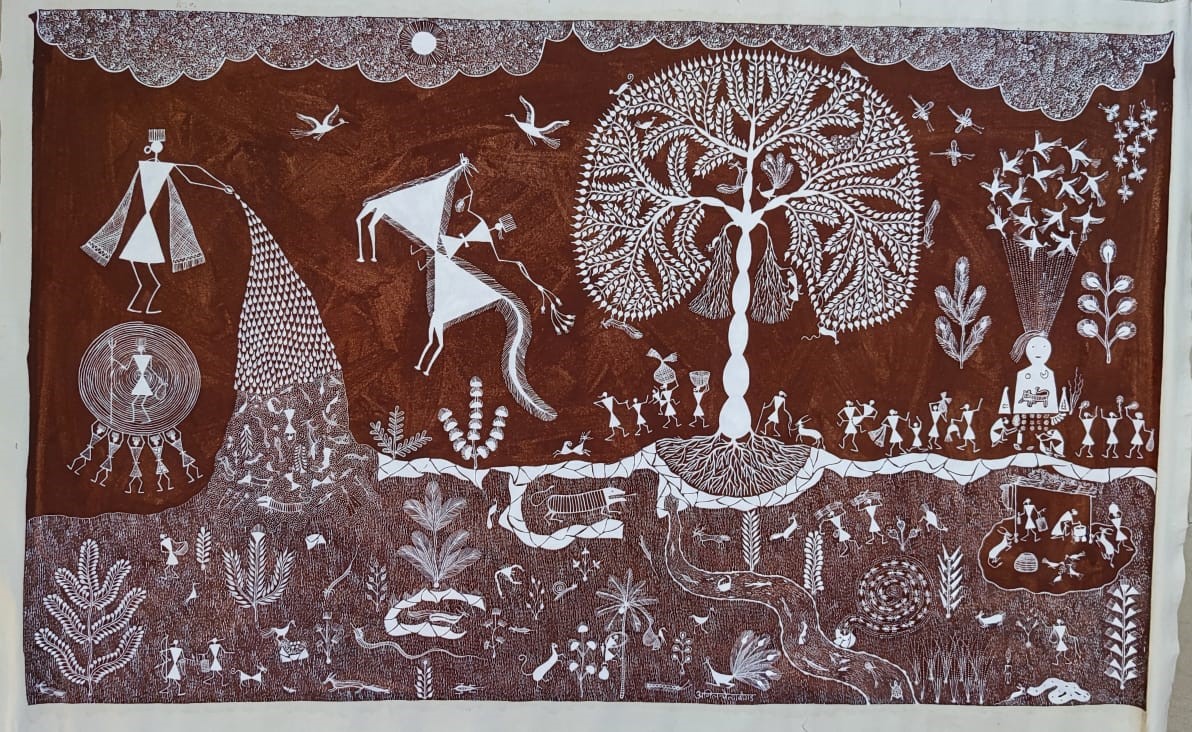
Warli Art
Warli painting is a style of art. This art is by the tribal people in the (North Sahyadri Range) in India. The Warli tribes live on both sides of Maharashtra and Gujarat’s borders. Warli art is known for its single-color depictions that express folk life customs, imaginations and beliefs. The sobriety in these colors contrasts with the happiness portrayed through the content found within them.
What our tribal artisans say
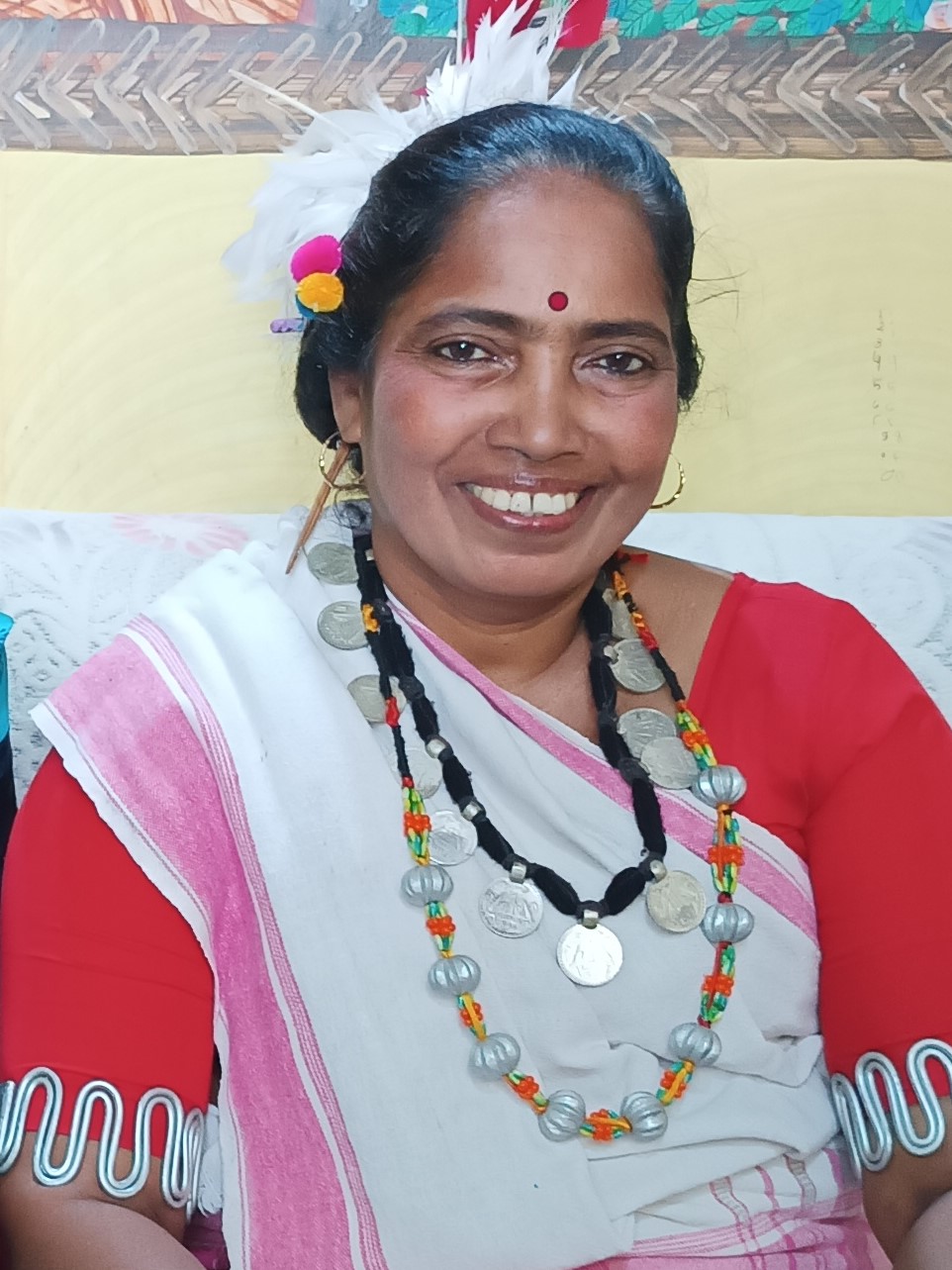
I use traditional Oraon tribal knowledge of painting imparted to me by my grandmother, mother and aunties.
Agnesh Kerketta
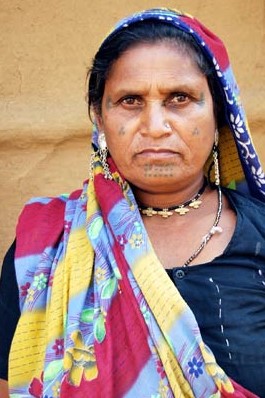
I learnt Bhil art from my mother Jhabbu Bai and still use natural materils to make my art.
Bhuri Bai from Zher

My name is Kalam Patua and I am a Kalighat artist who is innovative yet anchored in tradition
